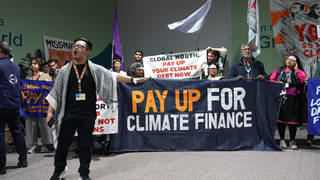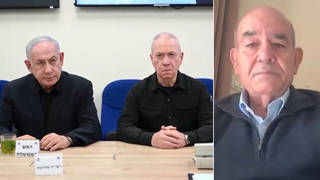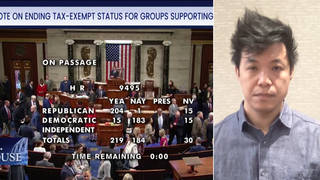
Related
Guests
- Mark Winston Griffithco-director of the Neighborhood Economic Development Advocacy Project, a community-based financial justice advocacy center.
- Lionel Ouelletteexecutive director of Changer, that organizes with home owners caught up in the subprime crisis.
We take a look at how the subprime mortgage crisis is affecting homeowners. The latest statistics show U.S. foreclosure filings nearly doubled in October from the same month last year. African American and Latino homeowners have been particularly hard hit. A new study finds that African Americans and Latinos were more than three times as likely as whites to have a high-cost loan. [includes rush transcript]
Transcript
JUAN GONZALEZ:
As we continue to discuss the economy, we turn now to look some more at the subprime mortgage crisis and how it’s affecting homeowners.
The latest statistics show US foreclosure filings nearly doubled in October from the same month last year. Nearly 225,000 foreclosure filings were reported last month, a 94% spike over October of 2006. And economists project the figures will only get worse in 2008, when some two million homeowners potentially face foreclosure when their adjustable-rate mortgages reset at higher rates.
African American and Latino homeowners have been particularly hard hit. A recent study by ACORN found that upper-income African Americans and Latinos were more than three times as likely as upper-income whites to have a high-cost loan.
AMY GOODMAN:
Rev. Jesse Jackson has announced he plans to hold a march on Wall Street on December 10th to put pressure on corporations to address the needs of Americans who have been devastated by the foreclosure crisis.
Meanwhile, Wednesday, a coalition of grassroots groups called on some of the nation’s largest investment banks to donate their holiday bonuses to a foreclosure prevention fund that will help prevent a new wave of foreclosures. The campaign is focusing on Goldman Sachs, Merrill Lynch, Morgan Stanley, Lehman Brothers and Bear Stearns.
Mark Winston Griffith joins us here in our firehouse studio. He is co-director of the Neighborhood Economic Development Advocacy Project, or NEDAP, a community-based financial justice advocacy center. Lionel Ouellette is also with us. He is executive director of Changer, that organizes with homeowners caught up in the subprime crisis.
Let’s start with you, Mark.
MARK WINSTON GRIFFITH:
Sure.
AMY GOODMAN:
Talk about the situation on the ground.
MARK WINSTON GRIFFITH:
Well, what we’re seeing on the ground is what you’ve already described. That is, people are losing their homes at an epidemic rate. And we’re seeing a discrepancy between what is happening to individuals and families and communities and sort of the response from government, as well as the corporate bodies that were responsible for this mess in the first place.
And so, the demonstration that we had yesterday was really trying to call attention to the fact that Wall Street bears a great deal of responsibility for the foreclosure crisis and the subprime crisis that we face today and that with responsibility comes accountability. And so, the idea that the five largest investment firms should invest or donate — use whatever word you want to use — their money, put that money towards a rescue fund for homeowners facing foreclosure is a way to acknowledge this responsibility and accountability.
JUAN GONZALEZ:
Mark, I remember we talked, I guess it was in February of this year, when I began writing a series of columns in the Daily News on the subprime crisis. And back then, people were saying, “Well, this is just the people who are the high credit risks who were reckless in taking more loans than they could possibly afford to pay. It’s not going to affect the rest of the market.” Now we’re here, like seven months later, and it’s an entire financial national crisis. This whole — the attempt initially by folks to stigmatize the borrowers as the problem — your reaction to that?
MARK WINSTON GRIFFITH:
Well, I think the problem is not individual. That is, it’s not about individual borrowers, it’s a structural problem. When you look at the fact that one out of four subprime loans is expected to go into foreclosure, that tells you that there’s something wrong with the system, with the product, with the whole enterprise of subprime lending. And so, something has to be done to change that, not the practices of individual borrowers, but the underwriting, the lending practices that have put these people in that position in the first place.
AMY GOODMAN:
Lionel Ouellette, you organize homeowners, tell us some of their stories.
LIONEL OUELLETTE:
One of our members, a Latina first-time home buyer, 760 credit score, which should make here eligible for the best loan products out there, got a subprime of 2/28, which is a loan that was fixed for two years, adjustable for twenty-eight, and with a balloon payment. 760 credit score should have the best product available. She lives in an apartment, and not even in the house, because she can get an apartment cheaper and still have extra money to help pay the mortgage on the house that she owns. And she’s hoping to refinance, to do something before it adjusts in 2008.
JUAN GONZALEZ:
And when you say a 2/28, can you explain? These interest rates jump phenomenally, right? Could you talk, the difference, what it means in terms of an actual payment suddenly after two years?
LIONEL OUELLETTE:
It can go from $2,300 up to $3,400 to $3,800 to $4,100. It can double.
JUAN GONZALEZ:
$4,100 a month.
AMY GOODMAN: A month.
LIONEL OUELLETTE:
$4,100 a month, yeah.
JUAN GONZALEZ:
And when you say a balloon payment?
LIONEL OUELLETTE:
Balloon payment means that you pay in five years, ten years or twelve years, depending on the mortgage, you can have a payment of $180,000 come due or the entire balance of the loan.
AMY GOODMAN:
Mark, tell us some of the stories of the people that you’re organizing with.
MARK WINSTON GRIFFITH:
Well, the thing about NEDAP — that’s my organization — is we work with a range of organizations that are engaging homeowners on a variety of levels — that is, foreclosure prevention and a lot of different ways, through direct counseling, through legal remediation, through intervention with the lenders themselves. And so, you know, on a regular basis, we are hearing these stories of how people have essentially been duped into these very just shady loans, shady products. And, you know, it’s coming from all ends. And so, when I hear people talk about, you know, the personal responsibility of the borrower, it really sort of — it gets us all upset, because we know that, again, it’s a structural problem.
JUAN GONZALEZ:
And the other thing that — you’ve also had several conferences or attended several conferences in terms of getting legislative action to help a lot of these homeowners. And I know Senator Chuck Schumer in New York and others have talked about finding some way to help people stay in their homes, but I’m surprised at how little has actually happened, either at state levels or at the federal level, to move on a crisis that’s almost like — it’s spreading so fast that it’s, if you do not act soon, it will be almost impossible to prevent, you know, hundreds of thousands of people from being forced out of their homes.
AMY GOODMAN:
Lionel?
LIONEL OUELLETTE:
When they found out that these toys that they were — I don’t know if it was Disney toys — had lead paint, they didn’t cut the price on them. They recalled them. These mortgages, it’s this similar effect, and they’re cutting the prices. Citigroup is writing down the bonds — I mean, writing down the value of these assets that are backed by, you know, the families’ — that we work with — mortgages. And it’s ridiculous, because there’s all these write-downs in terms of the value, but then none of that is passed on. Like, OK, we realize that the bond is not worth as much; well, that also translates, the loan that you made, the house isn’t worth as much. But none of that savings is going back to homeowners.
One family — one woman that I’m working with right now, another Latina first-time home buyer, makes $36,000 a year as a dental assistant, and the mortgage brokerage falsified her income as $76,000 a year, so that she would be qualified for a loan that was made by a mortgage company, Long Beach Mortgage Company, that is a subsidiary of Washington Mutual. And you asked to bring up legislation — Washington Mutual is not responsible for what it bought.
AMY GOODMAN:
It’s —-
LIONEL OUELLETTE: So -—
AMY GOODMAN: Keep going.
LIONEL OUELLETTE:
So, you know, without — and none of that legislation that’s being passed contains that, that element. They call it a signee liability. There is no sort of responsibility for the people that buy these predatory loans, these subprime loans.
MARK WINSTON GRIFFITH:
And could I just add that, you know, here we are almost in December, and we’ve been talking about this problem now for what? At least nine months. And it’s remarkable how little has happened on a federal, state and, in New York, on a city level to address this problem.
AMY GOODMAN:
Did you see the map in the New York Times of where these — where what you call these products are concentrated in New York City? Can you describe that for us?
MARK WINSTON GRIFFITH:
Well, we make maps ourselves. That’s what NEDAP — that’s one of the things that we do. And for years, we’ve had these maps that show that where subprime loans — in fact, the maps are being shown right now — where subprime loans are being made and where foreclosures are occurring are all concentrated in neighborhoods of color. So wherever you find a neighborhood of color and a high degree of homeownership, you will see foreclosures and you will see a high incidence of subprime lending.
AMY GOODMAN:
Nearly none in Manhattan?
MARK WINSTON GRIFFITH:
Nearly none in Manhattan. Well, right. There are not many homeowners in Manhattan, as well.
AMY GOODMAN:
Explain fixed rate to adjustable, what that means.
LIONEL OUELLETTE:
Well, a fixed-rate loan —
AMY GOODMAN:
Lionel Ouellette.
LIONEL OUELLETTE: — depends on the term. Like, most people want — when they say fixed rate, they think they’re getting — they’re going to have the same payment every month for the total length of the thirty years of their mortgage. Adjustable rate means that the rate of your mortgage will go up based on an index. And usually most loans in the United States are based on LIBOR, which is an index in London.
And — but what was happening was people would say, “I’m getting a fixed-rate loan,” and the mortgage broker would say, “Yeah, it’s fixed, it’s fixed.” It’s fixed for two years, and then they kind of whisper the two year part, or they don’t even say that. And so people — you know, people were — it’s not just a — it’s a housing crisis. We’ve always had a housing crisis, especially for people of color, low-income and working-class folks in this city, across the county. And so, people are in desperate need for housing, and somebody comes along and says, “Oh, no problem. You make this amount of money. It’s going to cost you $1,200 a month. You can do it.” And in that search for housing, they get caught up in these loan products.
JUAN GONZALEZ:
The other thing that you raise is the question of — I’d like to get a little more into the question of liability, the assigning of who’s responsible for this, because many people aren’t aware what happens to a mortgage once it is actually — once the loan is actually made. Usually, you’ve got a broker and a real estate lender and often an appraiser, because part of the problem is that in order to produce a large loan, you’ve got to get an appraiser who is going say this house is worth this much money.
And one of the things that’s happened now is it’s become clear that many appraisers were overvaluing properties, so the original loan was far greater than the house was worth. Then you have an interest rate that makes it difficult for the homeowner to buy. But then that loan gets sold to another mortgage company, which then collateralizes it in a huge bunch of similar risky loans, and then it appears on Wall Street as a bond issue, right? So that everyone is passing the bad loan on to someone else, and no one is assuming responsibility for having participated in this inflated value that continues to be passed on from one person to another.
MARK WINSTON GRIFFITH:
Right. In the old days, you used to know —- you know, there used to be a direct relationship between the borrower and the lender. And then, now -—
JUAN GONZALEZ:
It was usually a bank.
MARK WINSTON GRIFFITH:
Right, usually a bank. And now there are all these middle people with — you know, whose sort of prime directive is to sort of obfuscate who’s actually holding the loan. And so, when you’re the borrower, you know, there’s the originator, there’s the servicer, there are all these other people who are involved. And again, that’s when it becomes very difficult to assign responsibility and, if you’re the victim of fraud, to actually get some compensation for that, because essentially all that responsibility and liability has been just spread out over a series of people to the extent that it almost doesn’t exist.
AMY GOODMAN:
Are you — yes, Lionel?
LIONEL OUELLETTE:
The issue of the over-appraisals, Washington Mutual is being investigated by the Attorney General of New York State right now, in regards to their — and it was — they dug up emails, and they found emails where Washington Mutual was like, “No, we want these appraisers and this company to handle it, because we’re not happy with how some of the other appraisers are handling it.” And so, this is like one — it’s a great case because it points to one of the largest savings — I think Washington Mutual is the largest savings and loan in the country — and how they’re linked to this. And it doesn’t — unfortunately, the over-appraisal results in over-financing and just huge debt loads in communities. And that’s destructive to a community, as you know, and not — people would say, “Oh, rising housing prices are good.” Well, it’s not good if your debt load is in line with that. And there’s just not enough resources going to really help people keep their homes.
AMY GOODMAN:
Mark Winston Griffith, the march on December 10th, Jesse Jackson leading on Wall Street —
MARK WINSTON GRIFFITH:
December 10. OK, right, right.
AMY GOODMAN: On December 10th, going — dealing with Goldman Sachs, Merrill Lynch, Morgan Stanley, Lehman Brothers, Bear Stearns. Have any of these large financial institutions responded in a way you consider favorable? Are there any positive examples here?
MARK WINSTON GRIFFITH:
Well, our demonstration just happened, occurred yesterday. And we went to Goldman Sachs, actually, to deliver the letter, and we literally couldn’t get through the front door. So, no, I have not seen a response that I would consider favorable yet. I will give them the benefit of the doubt and say that there’s still some time for them to respond. But up to now — you know, that’s really what has — what was the instigation for us to do this in the first place is that Wall Street has not only been silent, but just has claimed no kind of responsibility, and we want to address that.
AMY GOODMAN:
I want to thank you both for being with us. Mark Winston Griffith is the co-director of NEDAP, the Neighborhood Economic Development Advocacy Project, which is a community-based financial justice group. We’ve also been joined by Lionel Ouellette, who is the executive director of Changer, organizing among homeowners caught in the subprime crisis. Thanks for joining us. We’ll link to your websites, as well, as well as Juan’s groundbreaking series of columns that he did in the New York Daily News.












Media Options